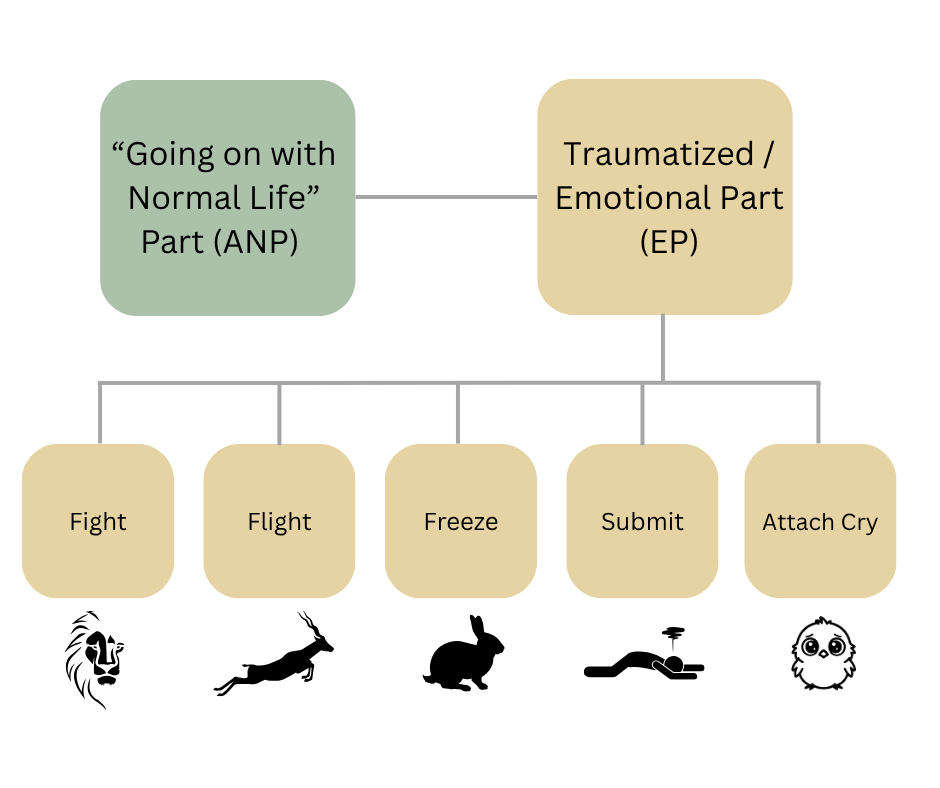The Flight Response: Why We Run from What We Need Most
Part 3 of The Fragmented Self: Our attempts to escape discomfort, why they don't work, and what to do instead
She's checking out the exits as soon as she steps in the room, her body angled toward the door, the flutter of anxiety whispering run, run, run.
This is the escape artist of our trauma defenses, the one that has turned avoidance into an art form. I know this territory well. I was a “runner” and it almost cost me my most important relationship.
The flight response in action is full of the desperation of someone fleeing a burning building. Where Fight builds walls and grabs weapons, Flight creates distance. It turns away, steps back, finds the nearest exit, and disappears into motion.
The Biology of Motion
Like its sibling Fight, Flight is a mobilizing defense. Both flood your system with the stress hormones adrenaline and cortisol, causing your heart to pound and your muscles to tense.
But while Fight moves toward the threat, Flight moves away from it.
The neurobiology is the same: your amygdala (warning center) sounds the alarm, your sympathetic nervous system (stress response) kicks into overdrive, and your prefrontal cortex (thinking brain) goes offline. But instead of clenched fists, you get restless legs. Instead of raised voices, you get sudden absences. Instead of confrontation, you get disappearance.
In the animal kingdom, the gazelle doesn't stay to negotiate with the lion.
It runs, and its life depends on how fast it can move.
The Ways We Escape
There are many ways to escape and avoid, and the flight response isn’t only literal running. My mentor, Janina Fisher, calls this the “sex, drugs and rock-n-roll part” for the creative ways it finds to avoid those pesky feelings.
I've worked with clients who moved across the country multiple times to escape emotions, who quit jobs the moment conflict arose, who ended relationships by ghosting.
But Flight can be far more subtle too. It can look like:
Relational Flight: Gradual withdrawal from intimacy just as relationships deepen. The friend who is unavailable and unreliable.
Emotional Flight: The avoidance of difficult feelings through distraction, busyness, or numbing. When an uncomfortable emotion arises, Flight reaches for a distraction.
Commitment Flight: The inability to stay present with anything that requires sustained engagement. Saying “yes” only to cancel later.
Somatic Flight: The disconnection from your own body when emotions become too intense. This can feel like being a “head on a stick”, with no sense of the body at all.
Self Inquiry: Which of these feels most familiar to you? Does your body tense reading about one particular type of flight?
That tension is information.
Flight has mastered the art of the graceful exit. It rarely slams doors, it simply slips out the back. It doesn't create dramatic scenes, it just gradually becomes unavailable.
It's the master of the slow fade, the gentle ghost, the disappearing act.
Flight would rather disappoint than risk being trapped.
Avoidance as Escape
In our hyper-connected world, Flight has found new and creative (and highly accessible) avenues for escape.
Social media becomes a portal to anywhere but here, as we scroll endlessly through other people’s lives, and avoid our own.
Excessive shopping offers the promise that the right purchase will transform our internal state, as we click “add to cart” and savor the brief hit of dopamine.
Food can be vehicle for escape through the altered consciousness that comes with blood sugar spikes and crashes… and it’s just a Door Dash away.
Substances offer one of the fastest and most direct forms of Flight. The chemical alteration of consciousness promises escape from whatever internal reality feels too intense.
Even so called positive addictions can serve the flight response. Workaholism, busyness addiction, exercise addiction, or compulsive helping can all function as sophisticated forms of avoidance that don’t raise eyebrows.
The Intelligence of Distance
But what if we could recognize the profound intelligence in the flight response? What if we could see that this part of us learned something crucial about the wisdom of strategic retreat?
Flight carries the memory of every time staying meant enduring the unendurable. It holds the knowledge of every situation where leaving was the only form of self-protection available. It remembers every relationship that became suffocating, every environment that felt threatening, every commitment that turned into a cage.
There's sacred wisdom in knowing when to leave.
When someone seems “flaky or “commitment-phobic,” they're not being selfish. It’s because commitments feel like a trap. They're trying to heal from a time when staying meant danger, and leaving meant safety.
Self Inquiry: Have you ever been called unreliable when you were actually just trying to survive? What would it feel like to have someone understand that your “flakiness” was actually your nervous system's attempt to stay safe?
There's intelligence in recognizing that not every battle is worth fighting, not every relationship is worth preserving, not every commitment serves your highest good. A discerning flight response can be a good friend.
But escape can becomes imprisonment if you’re not careful.
When avoidance becomes your primary coping strategy, you end up running from life itself.
Flight can keep you on the move so that you never develop roots. It can make relationships feel impossible because intimacy requires presence.
Flight can become so automatic that life becomes a series of beginnings with no middles, as you run from your own happiness.
The Paradox of Avoidance
Here's what Flight doesn't understand: the very emotions and experiences it's trying to avoid become more powerful when they are ignored.
When we push those emotions down into the basement of our psyche, they lift weights and then come back bigger, stronger and louder.
What we don't feel, accumulates. What we don't face, festers.
Try to avoid sadness, and it shows up in tears during commercials. Try to escape anxiety, and it manifests as accusations and projection. Try to bury anger, and it erupts as passive-aggressiveness.
The emotions you're running from aren't trying to destroy you. They're trying to tell you something important. But Flight is so focused on creating distance that it can't hear what they're saying.
Pause here for a moment. Take a breath. Notice if reading about avoidance is making you want to scroll to something else. That's Flight in action, reacting when it feels threatened
Creating Safety for Stillness
Healing the flight response isn't about forcing yourself to stay when it’s dangerous, but helping your nervous system learn discernment.
This begins with leaning in to discomfort through the radical practice of staying present when everything in you wants to run.
It might start with just sixty seconds of sitting with whatever emotion arises before reaching for your phone, your substance of choice, or your escape route of preference.
(I'm not immune to this. I've lost entire evenings to social media or busyness addiction when emotions felt too heavy.)
You can say to yourself: “I notice the urge to run. I notice the anxiety rising in my chest. I'm going to stay here with myself for just one minute and breathe. I can leave after that if I need to, but right now I'm going to practice staying.”
This practice gradually expands your window of tolerance and your capacity to be present with your emotions.
The Wisdom of Measured Movement
Teaching Flight about discernment is essential because there are times when leaving is exactly the right choice.
Healing comes through calming reactivity and learning to distinguish between strategic retreat and avoidance, between necessary endings and premature abandonment.
Flight holds the gift of mobility, the wisdom of movement, the intelligence of self-preservation. When it learns to trust your capital “S” Self to assess real danger versus phantom threats, it can transform from compulsive escape into conscious choice.
The art is learning to stay when staying serves your growth and to leave when leaving serves your healing, and recognizing the difference.
From my heart to yours,
Curious about your inner Flight part? Check out the Interactive guide:
Next week: The Freeze Response - When the Body Says Stop
Reflection Questions: What's your relationship with Flight? Do you recognize yourself in these patterns? Have you ever been misunderstood for behaviors that were actually survival strategies? Share your story in the comments - your experience might be exactly what another reader needs to hear.
And if this resonates, please restack it. There are people in your network who need to understand that their “flakiness” isn't a character flaw. It's a nervous system response that makes perfect sense.
If you're ready to move beyond just surviving your trauma, get access to trauma-informed tools and a therapist who understands the journey
Free, paid, liking, or lurking — I welcome and appreciate you. 🙏
Thank you for being here.
© Linnea Butler 2025









This was article was really packed with new ways of me viewing my avoidance tendencies. I for sure have the emotional and somatic flight show up often. Very eye-opening for me.
The line “flight would rather disappoint than feel trapped” resonated deeply with me. I feel that with every fiber in my being.
I often wish I had better measaures to activate flight "mode".
What if the opposite of flight, the reliving of memories of a former relationship becomes the default mode, the glorifying of what felt broken while in it, the ignorance that two people weren`t meant to be together.
I know this is very personal and still vague, but what you say there can also be too little of flight?